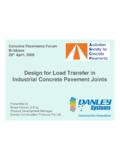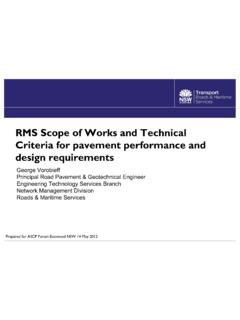Transcription of Concrete Pavement Design for Airfields
1 Concrete Pavement Design for AirfieldsRobert L SmithSenior Engineer Pavements & GeomechanicsAviation GroupAdelaide SAOutline Roads vs. Airfields Aircraft Landing Gear Brief History of Thickness Design Development of Design FAA (USA) Design Methods Australian PracticeDelivered to the Aust Society for Concrete Pavements June 2009 ForumRoads Wheel loads about 2 to 3 tonnes Tyre pressures about 750kPa Trucks have quite similar wheel arrangements, are of the same width and generally track along a narrow part of the Pavement Repetitions of the standard axle can be up to 108 Wheel loads are relatively close to the edge where moisture effects can be significantAirfields (Defence Airfields & Civilian Airports)
2 Wheel loads up to tonnes for Airbus A340-600 Tyre pressures up to 1600kPa and even as high as 3100 kPa on some fighter aircraft Wheel layout (or footprint) varies considerably between makes and models of aircraft Wander reduces as the aircraft lands on the runway and moves along the taxiway and across the apron to the aerobridge Repetitions can be in the range of about 10,000 to 100,000 Wheel loads are remote from the edge of pavements and equilibrium moisture contents are considered to apply Ingestion of loose stones into jet engines can be catastrophicB-747 (open contact areas)B-737 (shaded contact areas)SUPERIMPOSED FOOTPRINTSB rief History of Thickness DesignBased on US Army Corps of Engineers experience for military Airfields by R S Rollings (2003)1940 B-17 and B-24 WW2 bombers had a single wheel on each main undercarriage leg with wheel loads up to 18 tonnes Larger bomber (B-29) proposed with dual wheels on each main leg and 70% heavier Design used Westergaard's (1926) equations for a wheel load in the centre of the slab originally developed for roads Plate load tests ( dam) used to determine modulus of subgrade reaction (k) Third point beam test used to measure flexural strength1945 through early 1970s Larger aircraft (B-36)
3 Had single wheel loads of 34 tonnes 90 tonne wheel loads were contemplated but fortunately dual wheels used Strain measurements in model, test track and in-service pavements showed effective load transfer Westergaard s 1948 equations for a single wheel at the edge of the slab were developed Pickett & Ray (1951) developed influence charts for 2 or more wheels in a group Kreger (1967) computerised the above solutions 1970s Westergaard analysis approach showing its limitations F-15E fighter had 2300 kPa tyre pressure and this was causing damage to some pavements The effect of complex 3 leg main gear on the commercial DC-10 and the military variant as an air refuelling tanker, the KC-10.
4 Was of concern The Westergaard models could not not handle stabilised layers DC-10 Series 30 & 40 Footprint1980s onwards 1980s Layered elastic Design used for Concrete pavements as an alternative to Westergaard Late 1990s state of the art Finite Element modelling of pavements was being developed but military operational pressures put this on of Design Theoretical methods have evolved over time but have lagged behind the needs of the designer Considerable experience has been gained from observations of test sections, successful and unsuccessful pavements and the practice has been adapted as needed The importance of accumulated engineering experience over long periods and judgement has been a major factor in improving designsFederal Aviation Administration (FAA) FAA is the controlling authority for civil aviation in USA Sets Design standards for aircraft Pavement Design and other matters Design using charts for individual aircraft with formulae for calculations are presented in Advisory Circulars (AC)
5 AC 150/5320-6D Parts 1 to 5 plus amendments These AC cover Airport Pavement Design & Evaluation Spreadsheet Method Method is same as previous one but spreadsheet has macros to automate calculation Input aircraft mix and annual departures for each aircraft and Pavement profile Freeze thaw not generally applicable for Aust Spreadsheet based on critical aircraft and calculates equivalentdepartures for other aircraft in the mix Uses Imperial units only Need to understand FAA materials types (codes) Not to be used with aircraft with Triple Dual Tandem landing gear eg Airbus A-380 or Boeing 777B-777 Triple Dual Tandem main gearLayered Elastic Design Method Program LEDFAA Can select either imperial or metric units Mandatory to use this method with Triple Dual Tandem landing gear such as A-380 or B-777 in aircraft mix Covered by Chapter 7 of AC 150/5320-6D Change 3 No user manual but drop down help Element Method Proposed FAA method not yet approved for Design use Program FAARFIELD Version made available as a Beta version for evaluation or research A number of extensive reports are available on the software and its CONCC Originally used on mainframe
6 Computer, then on PC Only available as compiled Fortran Original code now lost Uses fixed format Fortran right adjusted, integers & floating point formats must be adhered to Careful attention to input data Determines thickness for given Concrete strength & k value Can consider 10 aircraft in the traffic mix Simulates influence chart method within 10% for 4 wheel gear Each leg is limited to 8 wheels Antonov An-124 (10 wheels per leg) cannot be directly simulatedBrisbane AirportPavements comprised the following 400mm plain Concrete 150mm crushed rock base (well graded to prevent pumping) 1500mm sand Subgrade of mangrove clayJointing Longitudinal joints are usually dowelled and formed Transverse joints are generally sawn to x Pavement thickness Keyed joints and tied joints are no longer used Temporary protection of sawn joints to prevent entry of construction debris Isolation joints are used at drains and structures and are commonly 20mm wide with compressible filler with sealant at the top In the past slabs up to m have been prone to cracking and spalling with loose Concrete fragments on the surface Slab sizes are now generally 5 to 6mConcrete 40mm maximum size aggregate used in mix This gives better aggregate interlock at sawn joints
7 Aggregates must be high quality, sound, durable & unweathered Minimum cement content 360 kg per cubic metre Strength specified as flexural (beam) tests - to MPa Beams must be 150mm square section Only rarely is compressive strength testing used and then 150mm diameter cylinders are required Water cement ratio maximum Slump 50mm maximumJoint Sealing Taxiways and Runway ends may have narrow unsealed joints On Aprons, where surface activity is high, joints are more likely to be sealed Initial saw cut widened to about 10mm for the sealant Sealants are silicone, polysulphide or polyurethane Self expanding cork is no longer usedReinforcement & DowelsReinforcement Pavements are predominantly plain (unreinforced) Concrete Mesh reinforcement is used in odd shaped (outside.)
8 1 ratio) or where pits or footings for light towers etc occur in apanel or where mismatched joints occur For 400mm thick slab SL 82 at 130mm coverDowels For 400mm thick slab R36 dowels at 375mm ctrs and 500mm longSpalling at grated drain inadequate isolation jointAn example of good joint detailingPCA & AIRpave Program Portland Cement Assoc (PCA) in USA has transferred rights to PCA Eng Bulletin EB050P Design of Airport Pavementby Robert Packard (1973, reprinted 1995) to American Concrete Pavement Assoc (ACPA) Program AIRpave 2000 Version (2001) is available from ACPA it is understood to be an update of the 1968 PCA program







